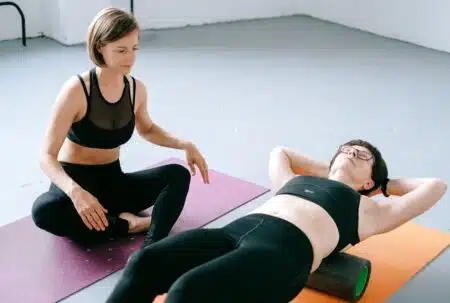Shoulder pain can seriously impact your quality of life. From enjoying hobbies to completing simple daily tasks, shoulder problems make everything more difficult. In this comprehensive guide, we’ll explore the anatomy behind shoulder pain, common causes, symptoms to watch for, and both self-care and professional treatment options to find relief.
Understanding your Shoulder Anatomy
Before diving into shoulder pain causes, let’s look at how the shoulder complex is built. Your shoulder is the most flexible joint in the human body, capable of moving in nearly every direction. This versatility comes from two main joints:
- The Glenohumeral Joint – This ball-and-socket joint connects the round head of your upper arm bone (humerus) into a socket on your shoulder blade. The “ball” shape allows your arm to rotate freely. This joint gives your shoulder an exceptionally wide range of motion.
- The Acromioclavicular Joint – Your collarbone (clavicle) meets your shoulder blade (scapula) to form this smaller joint. It facilitates overhead arm motions like lifting or throwing.
- Surrounding Muscles and Tendons – While the shoulder joints permit extensive mobility, the tradeoff is stability. To compensate, shoulder muscles, tendons, and ligaments encase the joints, providing control and support.
- The rotator cuff is a group of four muscles (supraspinatus, infraspinatus, teres minor, subscapularis) and tendons that keep the ball of the humerus in place. They initiate shoulder movements while preventing dislocations.
- Inside the joint capsule is the synovium – a membrane that secretes fluid to lubricate cartilage and tendons. Cartilage pads the ends of bones, preventing friction that could grind the joint surfaces.
With this foundational anatomy covered, let’s explore common causes behind shoulder pain.
Common Shoulder Pain Causes
Shoulder problems arise from muscle, tendon, ligament, cartilage, bone injuries or medical conditions. Typical culprits include:
- Rotator Cuff Injuries – The rotator cuff tendons can become irritated, inflamed or sustain tears from overuse or trauma. Symptoms include a dull, nagging ache made worse by overhead motions. You may also experience weakness, catching sensations, or trouble sleeping on the affected side.
- Frozen Shoulder – Also called adhesive capsulitis, frozen shoulder occurs when inflamed shoulder capsule tissues tighten, restricting mobility. Diabetics are at increased risk. Pain may spike at night or when reaching across the body, combined with progressive loss of external rotation.
- Impingement Syndrome – When shoulder bursa or rotator cuff tendons become inflamed, they can get pinched near the acromion bone. This causes pain raising your arm sideways or overhead. It’s often an overuse injury in athletes or workers performing repetitive overhead motions.
- Arthritis – Osteoarthritis breakdown of shoulder cartilage and bone is less common than other joints unless you’ve sustained prior injury. Rheumatoid arthritis – an autoimmune condition – can also spark shoulder inflammation. Joint degeneration provokes stiffness and aching, especially at night or in cold weather.
- Bursitis – There are over 150 bursae – fluid-filled sacs that cushion areas where tendons or muscles move across bones. Shoulder bursitis occurs when these become irritated. It triggers localized swelling, tenderness, and pain that limits mobility.
- Muscle Strains – The intricate network of muscles surrounding the shoulder joint are vulnerable to pulls and tears. Strains cause intense pain at the time of injury which gives way to stiffness, bruising, muscle spasms, and weakness as they heal.
- Dislocation – Recall the shoulder socket is quite shallow to allow for freer range of motion. As a result, it’s easier to partially or fully dislocate compared to more stable joints like the hips. This leads to immediate, severe pain combined with a visibly deformed shoulder contour.
- Pinched Nerves – Herniated discs or bone spurs in the neck can press on nerves that run into the shoulder and upper extremities. Referred shoulder and arm pain combines with numbness, tingling and reduced coordination or grip strength.
- Underlying Conditions – Systemic diseases like lung cancer or polymyalgia can also provoke shoulder soreness. Pay attention for other unusual symptoms and see your doctor promptly if shoulder pain arises rapidly or persists longer than 2-3 weeks.
Now that we’ve covered some common shoulder pain causes, let’s explore warning signs not to ignore.
Red Flag Symptoms
Most shoulder discomfort resolves relatively quickly with conservative treatment. However, certain red flag symptoms warrant prompt medical attention. Seek emergency care if you experience:
- Sudden swelling and bruising after an injury – suggests possible bone fracture or torn blood vessel Joint instability, dislocation or deformity loss of pulse, pallor, coldness in the arm – indicates possible vascular injury
- Fever, nausea, dizziness or generally feeling unwell
- Rapid onset of severe bilateral shoulder pain – potential sign of polymyalgia or other inflammatory condition
Now, let’s review natural self-care techniques to manage shoulder discomfort at home
Treating Shoulder Pain at Home
Unless you’ve sustained major trauma, most shoulder pains can initially be managed with self-care:
- Rest – Take a break from aggravating activities to calm inflammation. But don’t overdo inactivity as freezing the joint leads to stiffness. Find an equilibrium between rest and gentle movement.
- Ice/Heat – Ice packs reduce swelling and pain after acute injuries for 15-20 minutes several times per day. Allow skin recovery between applications. Alternatively heat relaxes muscles, boosts blood flow and eases chronic stiffness.
- OTC Medication – Anti-inflammatories like ibuprofen or naproxen ease discomfort and swelling. Consult your pharmacist for dosing specifics or possible interactions with other medicines you take.
- Posture/Ergonomics – Evaluate your desk set-up, sleeping positions or how you perform chores. Simple adjustments to alignment and movements can significantly reduce repetitive strain.
- Assistive Devices – Strategically use pillows, slings, grab bars and other supports to restrict painful motions while recovering. Shopping carts or backpack straps evenly distribute heavy loads offloading strain.
- Targeted Exercises – Gentle range of motion and strengthening exercises keep your shoulder flexible and stable. Perform them consistently for best outcomes. Stop immediately if anything causes sharp pain.
When home care strategies fail to deliver adequate relief after several weeks, it’s time to seek professional treatment. Let’s explore common shoulder pain therapy options.
Seeking Professional Shoulder Pain Treatment
From medications to surgery, your doctor has many tools to tackle shoulder problems persisting despite self-management.
- Prescription Medications: For moderate to severe discomfort, muscle relaxants or stronger prescription pain pills may be warranted short term in combination with anti-inflammatory medication.
- Steroid Injections: Injecting corticosteroid medication directly into irritated shoulder structures provides potent anti-inflammatory effects. Ultrasound imaging pinpoints delivery into tendons, bursae, joints or nerve roots. Relief starts quickly but may only last several months.
- Hyaluronic Acid Injections: Similar to the synovial fluid naturally present in joints, viscous hyaluronic acid injections supplement joint lubrication and shock absorption. Most effective for mild arthritis pain, effects emerge gradually but persist for 6 months up to a year.
- Physical Therapy: Hands-on techniques like massage, stretches and joint mobilization combine with tailored strengthening plans. Therapists analyze posture, movement patterns and work ergonomics. This addresses root causes, prevents future flare-ups and restores function.
- Surgery: When more conservative measures fail and disabling pain persists, shoulder surgery becomes an option. From arthroscopic procedures to repair damaged structures or total joint replacement, techniques span from minimally invasive to open reconstruction.
Let’s explore these professional treatment options in more detail.
Physical Therapy
Physical therapists offer diverse treatment strategies centered around gentle joint mobilization, soft tissue manipulation, activity modifications and therapeutic exercises. Sessions focus on:
- Postural Retraining: Faulty shoulder, neck or spine positioning strains muscles over time. Therapists provide biofeedback to fix poor mechanics.
- Manual Therapy: Massage, joint traction maneuvers and myofascial release soothe irritated tissues. Passive range of motion movements fight developing frozen shoulder.
- Strengthening Plans: Strategic exercises reinforce shoulder musculature to stabilize joints and promote proper tracking during activity. Therapists tailor programs to each patient’s capabilities and challenges.
- Functional Retraining: Patients relearn proper lifting, carrying and overhead motion techniques. Therapists also address sports or vocational demands through simulated activities.
Physical therapy empowers patients with tools and strategies to self-manage discomfort and prevent future flare-ups.
Steroid Injections
Shoulder bursitis, tendinitis or arthritis causes inflammation that thickens and sensitizes local tissues. Steroid injections deliver concentrated anti-inflammatory medication. Common sites include:
- Subacromial Space: Treats rotator cuff impingement, bursitis and adhesive capsulitis Glenohumeral Joint: Addresses arthritis pain and inflammation within the shoulder joint itself. This area can also be injected for adhesive capsulitis.
- Acromioclavicular Joint: Calms arthritis, bursitis and separation inflammation between the collarbone and shoulder blade.
Ultrasound imaging allows precise needle guidance to affected tissues. After cleaning the skin, the physician inserts a thin needle into the tender zone. They may first inject numbing lidocaine before infusing the corticosteroid. Most patients feel immediate pain relief as anti-inflammatories start tamping down local inflammation.
Benefits peak in 1-2 weeks and last an average of 3-6 months. Some find longer lasting relief up to a year while others require repeat injections when symptoms recur. Potential complications like infection or nerve injury are rare when performed by an experienced practitioner.
In some cases, your physician may combine shoulder joint injection with manipulation under anesthesia to rip adhesions in frozen shoulders. They’ll prescribe post-procedure physical therapy to prevent recurrence of scar tissue contractures. Surgery remains an option if conservative treatments repeatedly fail.
Hyaluronic Acid Injections
Osteoarthritis breaks down cartilage pads cushioning bone ends within joints. This causes friction, inflammation and compensatory bone spur formation. Hyaluronic acid closely matches synovial fluid consistency surrounding joint tissues. Injections temporarily restore some of this shock absorption and lubrication.
Most effective for mild arthritis pain, it can stall disease progression to delay need for surgery. Pain relief emerges gradually over several weeks versus the rapid response of steroid injections. However, benefits often exceed 6 months to 1 year since the thick fluid remains longer than anti-inflammatory medication effects.
The physician slides a needle into the arthritic shoulder joint and then infuses the thick hyaluronic acid bolus on ultrasound or x-ray guidance. This replenishes some of the cushioning fluid film protecting cartilage and tendons. By lubricating joint movement and absorbing impact stress, symptoms improve allowing gentle return to normal activities with less discomfort.
Surgery: Last Resort for Recalcitrant Shoulder Dysfunction
Severe, persistent shoulder problems causing disability may ultimately require surgery when conservative measures fail to provide adequate relief. From realigning dislocated joints to total replacements, options range from minimally invasive to extensive reconstruction.
Common procedures include:
- Arthroscopic Surgery: Small camera-aided keyhole techniques allow repair of damaged rotator cuff tendons, removal of painful bone spurs or release of frozen shoulder contractures through dime-sized incisions. This reduces hospitalization and recovery times.
- Total Shoulder Replacement: For severe, untreatable arthritis, total shoulder replacement implants metal and plastic components mimicking the anatomical ball and socket. Reverse designs substitute a plastic cup for the ball on the humerus with a metal ball on the scapula for specialized cases. Candidates must possess intact rotator cuff function.
- Joint Fracture Surgery: Severe shoulder trauma can shatter bones requiring open incision or keyhole fracture stabilization using plates, screws or pins. This urgently realigns joints to protect blood vessels and nerves.
Rehabilitation via post-surgical physical therapy ensures optimal recovery of flexibility and strength. Consistent home exercise builds muscles so they can properly stabilization your new joint. While range of motion may not fully recover, most experience significantly less pain and restored function.
Putting It All Together: Seeking Shoulder Pain Relief
We’ve covered shoulder anatomy, common causes of discomfort, home remedies, and professional treatment options from physical therapy to surgery. Addressing shoulder pain requires patience through gradual steps:
- Start with RICE self-care (rest, ice, compression, elevation)
- Progress to gentle movement and postural correction
- See a physical therapist or doctor if home techniques fail after 2-3 weeks
- Consider steroid injections to dampen inflammation
- Discuss surgery only if disability persists despite extensive conservative care
- Committing to rehabilitation exercises after professional treatment prevents repeat injury. Paying attention to early warning signs allows prompt intervention before small problems cascade into more severe disablement.
While shoulders permit great mobility, their vulnerability to instability and strain make them high-risk joints. But with thoughtful self-care, expert guidance, and consistent reconditioning, you can get back to full function.
Hopefully this guide brought clarity to shoulder pain causes along with a roadmap to effective treatment.



